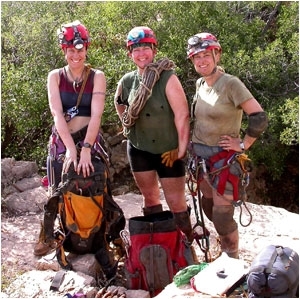 |
| (L to R) Hazel Barton, Pat Seiser and Tama Cassidy following a week-long expedition in Lechuguilla Cave, New Mexico. |
Airhart: So when did you start caving?
Barton: When I was 14, I took an Outward Bound course. I actually thought I was claustrophobic and I thought going caving would be a good way to get over it. And I still haven't gotten over it yet — much to my mother's chagrin.
Airhart: The claustrophobia or the caving?
Barton: The caving! I'm still doing it after all these years!
Airhart: Do you ever get claustrophobic in caves?
Barton: There's been a couple of times when I've been deep underwater in a submerged cave, cave diving when it's gotten very, very tight. And with the mask and the regulator on your face, very low visibility and being deep underwater and only having so much air, there's been a couple of times that my chest has felt a little bit tight. But that's been about it. So I think I'm officially not claustrophobic.
Airhart: I saw the IMAX film "Amazing Caves," which you were in a few years ago. And I still vividly remember that scene where you're underwater and you're going through a small hole in the rock and you have to take your oxygen tank off and push it through the hole first to fit through because the hole is so small. Just watching it made me feel claustrophobic!
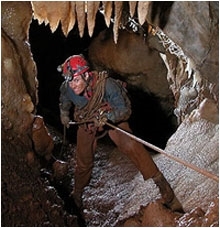 |
| Hazel Barton, Black Chasm Cave, CA. (Image courtesy of Dave Bunnell) |
Barton: That was a big hole — that was pretty easy. You don't know it, but the producers have a sound track and they actually have an extremely low frequency bub, bub, bub going in the background and what it does is it speeds up — you feel it in your chest a bit, so you almost feel like your heart is starting to speed up too. And it scares the bejeebees out of people. And they don't even realize it. And it's this ultra low bass playing. It's a trick there from movie making, if you ever get into that.
We had to do that shot seven times to get it because the camera couldn't fit. So they had to swim the long way around and then film me coming through.
Airhart: You've been a caver most of your life. And you're also interested in microbes. When did you start combining those two interests?
Barton: It was about five years ago, I started working for a professor at the University of Colorado called Norm Pace. And he's probably one of the — if not the — preeminent microbial ecologists in the world. And I got into it doing microbial ecology with him.
My Ph.D. is just classical medical microbiology. And it's really only recently — in the last 15 or 20 years — that we've realized that there's a world of microbiology outside of those organisms that make us sick. Pretty much everything we know and understand about microorganisms comes from the ones that make us sick. And these are a few hundred species out of the potential 200 million species of bacteria on Earth. So we really don't know anything about the microbial world. Even though we've had the microscope for 300 years, we still don't know what's going on.
So I started working with him [Norm Pace] on other projects. And he said, well, why don't you go do some cave stuff. And I said I don't want to do microbiology in caves. Caving is what I do for fun. I don't want to make it my job.
The thing is, there were questions in microbial ecology that we could only answer by going into caves. So by going into caves and doing this research, we were able to answer these questions that nobody else could because they couldn't get there to do the research.
So what we're doing now is combining my ability to go where not many people can go in the first place and taking in the knowledge of someone who's a trained microbiologist into that location. So I got more and more into it. And now I'm a full time tenure track faculty here who's job is 50 percent teaching, 50 percent researching microbial ecology in these caves.
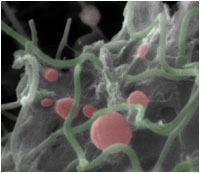 |
| A false color scanning electron microscope image of Archaea cells from a cave in Colorado. (Image courtesy of Hazel Barton) |
Airhart: So now that you've combined the two, how is it working out for you?
Barton: One of the things I was always worried about was that when I started doing this that caving would become a job. But it's not. Now what I find is that when I explore a cave, I'm always looking for clues about how the cave formed. If you find out how a cave formed, you know where the cave's going to go and you can kind of push it in that direction and explore new passages. And this is how you successfully explore a cave.
Well, I do the same thing now but I'm not just looking for clues about how the cave formed, I'm looking for clues as to how microbes had a role in that. And it will be surprising. I'll be walking down a passage picking my nose or something and I'll be looking at a rock and I'll go, that's strange, what's that? And I'll just kind of go up to it and poke it with my finger and before I know it, there's another project. But we have to be very careful what we do. It's very easy to go off on a tangent and one of the great things I have is I've worked with some of the very best people in microbiology in the U.S. And they taught me how to really focus on the research.
Airhart: So what is the focus of your research?
Barton: Primarily what we're trying to do is understand how life lives in very starved environments on Earth.
What we think based on study of microorganisms in the environment and the evolution of life is that macroscopic life — life you can see on the surface of the planet — may be an evolutionary burp. And that the majority of life actually lives in the subsurface down through the rock of Earth itself to several miles below our feet. So as much life as you see on the surface may be insignificant compared to the life below our feet.
So a lot of that life is going to live in what we would consider an extremely starved environment — an environment with maybe one milligram per liter of energy. In other words, if you take a grain of sugar and dissolve it in a liter of water, that's about how much energy is supporting these ecosystems living in the subsurface.
So what we're trying to do is understand how they live in these environments and it's very difficult to do because most of the time to get at them, you have to drill down and do a lot of damage. Whereas caves allow us to go in and look at that interaction directly. So that's why caves are such a valuable tool in doing that.
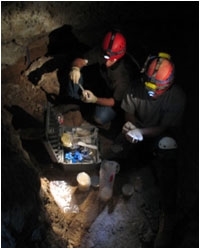 |
| (L to R) Nick Taylor and Adin Pemberton collecting samples in Carlsbad Caverns, NM. (Image courtesy of Hazel Barton) |
And there's one other thing. What we're finding is that the microbes are taking energy from sources that we wouldn't imagine. For example, they may be taking organic molecules out of the air itself. So for example, as you and I walk around and breathe and talk, we're producing organic molecules that go into the air and these microbes can actually grab them out of the air itself and use them for energy.
They can also chew into the rock — so there are sources of energy in the rock itself. And these organisms are able to go in and pull these sources of energy out and as a result, change the structure of the rock. In doing so, they leave behind a mineral biosignature. And this biosignature is very stable because now basically they've taken one rock and changed it into another rock, so they are stable over geologic time. And that's a very good tool for astrobiology. If we can understand the changes that these organisms create in rocks under certain conditions and with certain nutrient sources, you can use those as markers on Mars or maybe on other planets with rock outcrops to look for evidence of past life.
On Mars, when they looked for evidence of past water, they looked for minerals that can only form through the processes of water. Well we're looking for minerals that can only form through the processes of life.
Airhart: So how is that work going?
Barton: We've actually got microorganisms growing in the lab that were extracted from these cave environments that have no nutrient supply. These came from Carlsbad Caverns in New Mexico last June.
We haven't given them any food. They're growing in distilled water — very pure water. And they're precipitating a mineral and we can't figure out what it is. It's like nothing we've ever seen before. They're scavenging enough nutrients out of distilled water that they actually precipitate a crystal.
With this idea of trying to understand how starvation affects the microbes, we were looking at different locations within Carlsbad and how nutrients affected how these microbes interacted with the rock in which they lived. And what we found was that when there were plenty of nutrients coming in, a drippy area where these nutrients were coming in from the surface, they really didn't make any change to the structure of the rock. It stayed pretty much the same.
We went to starved areas of the rock where nothing was coming in from the atmosphere. These microbes had chewed into the rock so far that the first inch and a half was just a powder — that was all that was left of the rock, a very fine powder. Everything else had been digested.
Airhart: I understand that another reason to study microbes in starved environments is that they may yield new antibiotics to treat human illnesses. Can you tell me about that?
Barton: Most of the antibiotics that are used today come from the same group of microorganisms called the actinomyces. It's a very good group to produce antibiotics from.
When these organisms starve they produce antibiotics as a way of grabbing nutrients from their neighbors — basically, they kill their neighbor and suck all the nutrients out of them.
What we're trying to do is take that to another group. If we look at organisms that only live in starved environments, can we find new branches on the tree of life that contain microorganisms that produce antibiotics? If we can, are they different enough in structure and mechanism of action than anything we have now that when we use these on a patient the chance of antibiotic resistance occurring are much, much lower?
Airhart: So what's an example of a disease you hope to find antibiotics for?
Barton: One that's really significant for people in the United States is caused by an organism called Staphylococcus aureus. And this is the same bug that causes pimples and gives you boils. It's just a nasty little organism.
And the thing that's unique about it is it can grow in virtually any tissue in the body. Most organisms can not because your immune system is so good at protecting yourself that they can only grow in your lungs or kidneys or your intestines. This guy can grow anywhere. So you can get an infection anywhere.
And now we have a multi-drug resistant form of this because it's very good about picking DNA up from the environment. And very quickly, there developed a multi drug resistant version of Staphylococcus called MRSA — Methacylin Resistant Staphylococcus aureus.
If you go to nursing homes or hospitals, there are MRSA wards, because if you take a patient who is uninfected and put them next to a patient who has MRSA, because there's nothing you can do to stop that new patient being infected with MRSA and then there are no drugs that you can use to treat them.
Now we had one drug left to treat them and that was Vancomycin. And as long as we had that, if someone was on death's door, at the last minute, we could pump them full of Vancomycin and save their life. Well they've just found a Vancomycin resistant version of Staphylococcus aureus. So it's now resistant to every known antibiotic that we have. There's nothing we can use against it.
So we're now in the pre-antibiotic age when it comes to dealing with this pathogen. So if you have an infection with this organism, there's nothing we can do to help. The only thing we can do is supportive care — the same things they were doing 100 years ago.
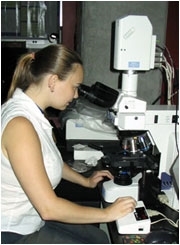 |
| Jennifer Millette examines cave microbes using a fluorescent microscope. (Image courtesy of Hazel Barton) |
Airhart: That's scary!
Barton: It's very scary. And the thing is the drug companies want to make a billion dollars on a drug that cures erectile dysfunction. It's like, "Well, rich people don't die of this often, so who cares?" Agh!
Airhart: So you're trying to develop drugs that will help?
Barton: No. I don't think so. I'd like to say yes. It's not my area of expertise. I'm good as a microbiologist at finding these things. The pharmacology of purifying and testing these things is way over my head. I have collaborators that do that.
My problem is I'm too much of a scientist. And the question is always the big carrot. I know that sounds terrible — I should be more of a humanitarian than I am. I'd like to draw more awareness to it, that it's an issue. And I think with the IMAX movie, there was at least an opportunity to get people excited about this kind of research and think it was valuable and important.
Airhart: So why do you do this work?
Barton: Ever since I was a little kid, it's always been, "Why?"
Someone once told me it only takes four "why?"s to get to cutting edge science. You know. Why is the sky blue? Well, the atmosphere scatters light. Why does the atmosphere scatter light? Well, the atmosphere acts as a prism and splits light. Why? All of a sudden you're into advanced physics.
So I always have to know how things work. You kind of gravitate towards the things that intrigue you the most.
And when I was, oh, crikey, 12, we were doing this thing in biology class — it was our first microbiology lab ever. And we had to go find microbes. So I brushed my hair over this petri dish and something really disgusting grew out of it and I thought that was the coolest thing. And there's a lot of gratification — not so much now because these organisms that grow in these caves, it takes six months to see anything — but the gratification of doing something one day and your result is there the next day. There's certainly something about that.
Page created on 3/18/2006 7:19:31 PM
Last edited 1/9/2017 10:33:22 PM

"So what we're trying to do is understand how [microbes] live in these environments and it's very difficult to do because most of the time to get at them, you have to drill down and do a lot of damage. Whereas caves allow us to go in and look at that interaction directly."